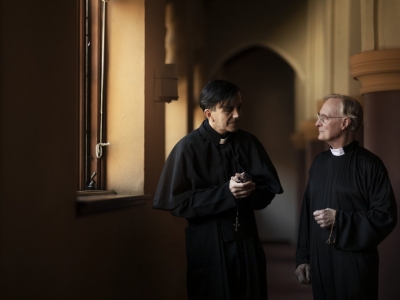The distinctions between Catholicism and Protestantism have not only shaped Christian history, they have also had a profound impact on the formation of modern Europe and its diverse cultures. Before delving into the specifics, it is essential to understand that these two branches of Christianity have much in common, such as the belief in Jesus Christ as the saviour of mankind. However, the differences are just as important and worth studying.
History and Origins
Catholicism
Catholicism dates back to the first followers of Jesus and has been the main form of Christianity for almost 1,500 years. It is characterised by a historical and doctrinal continuity that begins with the apostles and continues to the present day, centred around the episcopal see of Rome.
Protestantism
Protestantism emerged in the 16th century in response to concerns about Catholic practices and doctrines. Initiated by figures such as Martin Luther, John Calvin and others, the Protestant Reformation led to the separation of many churches from papal control and Catholic tradition.
Hierarchical structure
Catholicism
In Catholicism, the structure is strictly hierarchical. The Pope, considered to be the successor of the Apostle Peter, holds the highest level of authority, followed by cardinals, bishops and priests. This hierarchy is seen as a means of maintaining the unity and continuity of the faith.
Protestantism
Protestantism offers a wide variety of organisational structures, ranging from independent evangelical churches to more organised Presbyterian denominations. The emphasis is often on the local church community, rather than a centralised authority.
The Seven Sacraments and The Two Ordinances
Catholicism
Catholicism teaches the importance of seven sacraments as means of grace and sanctification. These include baptism, confirmation, the Eucharist, penance, the anointing of the sick, Holy Orders and marriage.
Protestantism
Protestantism simplifies this concept by generally concentrating on two ordinances or sacraments: baptism and Holy Communion. These rites are seen as commandments from Jesus but not necessarily as means of grace in the same way as in Catholicism.
The Bible and Tradition
Catholicism
Catholicism values Tradition with a capital "T", encompassing the writings of the Church Fathers, the decisions of councils and other aspects of ecclesiastical tradition as complementary to Scripture.
Protestantism
Protestantism, based on the principle of "Sola Scriptura", emphasises the Bible as the one and only source of authority in matters of faith, which often minimises the role of ecclesiastical traditions.
The Role of Mary and the Saints
Catholicism
The Virgin Mary occupies an important place in Catholic theology and piety, being venerated as the Mother of God. Similarly, the saints are honoured and invoked as intercessors.
Protestantism
In contrast, the majority of Protestant traditions eschew the veneration of Mary and the saints, focusing exclusively on the direct relationship between the individual and God.
Conclusion
Catholicism and Protestantism are two major expressions of Christianity that share many beliefs but differ significantly in structure, sacraments, sources of authority and the roles of spiritual figures such as Mary and the saints. Understanding these nuances is not only enriching for the faithful, but also for anyone interested in the complexities of faith and history.
FAQ : Catholics and Protestants
What are the origins of Catholicism and Protestantism?
Catholicism is one of the oldest branches of Christianity, dating back to the first disciples of Jesus. Protestantism, on the other hand, emerged in the 16th century with the Reformation, initiated by figures such as Martin Luther and John Calvin.
What is the hierarchical structure in each denomination?
In Catholicism, the hierarchy is highly structured, with the Pope at the top, followed by cardinals, bishops and priests. Protestantism, on the other hand, has a variety of structures, often more decentralised.
How many sacraments are there in each denomination?
Catholicism recognises seven sacraments: baptism, confirmation, the Eucharist, penance, the anointing of the sick, Holy Orders and marriage. Protestantism generally recognises two: baptism and Holy Communion.
What is the role of the Bible and Tradition?
Catholicism values both the Bible and ecclesiastical Tradition. Protestants focus more on the Bible as the sole source of authority, according to the principle of "Sola Scriptura".
What is the role of Mary and the Saints?
In Catholicism, Mary and the saints occupy an important place and are venerated. In Protestantism, the emphasis is more on the direct relationship between the individual and God, and the veneration of Mary and the saints is generally avoided.
Are there sub-groups within Protestantism?
Yes, Protestantism is a branch of Christianity with many denominations, including Baptists, Methodists, Presbyterians, Lutherans and many others.
Do Catholics and Protestants read the same Bible?
Generally, both groups read very similar versions of the Bible, but there may be differences. For example, the Catholic Bible includes the Deuterocanonical books, which are not present in most Protestant Bibles.



 The Mystery of the Five Wounds of Christ: A Profound Exploration of Their Spiri
The Mystery of the Five Wounds of Christ: A Profound Exploration of Their Spiri  Women's religious orders: A heritage of service and education
Women's religious orders: A heritage of service and education  What is Secours Catholique?
What is Secours Catholique?  Jesus' 40 Days in the Desert: A Spiritual Exploration
Jesus' 40 Days in the Desert: A Spiritual Exploration  In un mondo di connessioni costanti e distrazioni digitali, la Quaresima si sta
In un mondo di connessioni costanti e distrazioni digitali, la Quaresima si sta